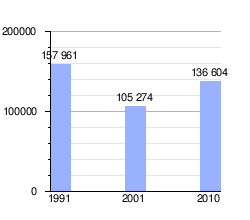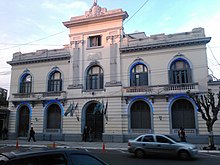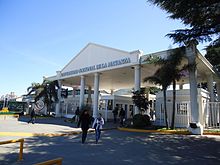San Justo (Buenos Aires)
San Justo is an Argentine town, head of the La Matanza district, in the western area of the Buenos Aires metropolitan area. It is located 2.5 km from the border with the Autonomous City of Buenos Aires. It is the headquarters of the National University of La Matanza.
History
The party of La Matanza, whose identity dates back to the beginning of the XVII century, remained uncounted for a long time with a capital city, not due to lack of initiatives but due to various circumstances that prolonged it.
In 1852, the justice of the peace, Lino Lagos, who was also head of Government, made the first requests to obtain the land necessary to establish a capital city. However, it was not until June 1856 that it was achieved. José Gorchs, representing the heirs of Justo Villegas, proposed that the foundation be built on the lands they owned and were willing to donate to the community. They also clarified that this donation was intended to provide a public service. A municipality, a church, a school and the security administration would be built there.
The lots delivered also included land for the construction of a cemetery, a market and a residential area. To carry out the works, 20,000 pesos were also delivered. On August 5, the donation was accepted and on December 25, 1856, the city of San Justo was founded, placing the foundation stone on the property now occupied by the Italian Hospital; At the request of the heirs of Justo Villegas, it was decided to call the city "San Justo" and on January 8, 1857, the formation of a municipal corporation was requested. On March 5 of that year it began to operate, made up of local residents: Joaquín Madariaga, Vicente Silveyra, Hilario Schoor and Emilio Villegas.
The demarcation of the town was in charge of Melchor Romero; It was approved on November 13, 1857 by the Department of Topography of the province, thus being limited to one square league.
On July 7, 1929, the municipal palace, headquarters of the mayor's office of the La Matanza district, was inaugurated during the administration of Mayor Crovara.
Geography
Location
The city of San Justo is located just over 3 km from the Federal Capital and covers an east-west sector with an approximate length of 7 km and a width of 4.
Limits
Its limits have been evolving according to the different decrees, ordinances and customs, which were marked over the years from that close-up of Melchor Romero. On June 20, 1858, the plan that dictates the limits of the city ejido was approved; These were demarcated by the classic mile (1632 meters) and enclosed in it the lands of the donors, including those of other illustrious neighbors, among them: Margarita Lino Lagos, the Ramos Mejía family, the Pueyrredón family and others.
Currently the lands donated by the Justo Villegas family are located between Berro, Rincón, Don Bosco and Rivera Indarte streets.
San Justo borders the towns of Ramos Mejía, Lomas del Mirador, La Tablada, Ciudad Evita, Isidro Casanova and Villa Luzuriaga.
Its current limits are La Paz, Rivera Indarte, Alberto Lartigau, Camino de Cintura, Venezuela with Villa Luzuriaga, Pedro León Gallo, Juan Manuel de Rosas, José Ignacio Rucci with Isidro Casanova, Avenida Intendente Crovara, with Ciudad Evita Camino de Cintura, Peribebuy, with La Tablada, Formosa with Lomas del Mirador, Avenida Gral. Mosconi, Roca railway tracks with Ramos Mejía.
Streets
The streets of the historic center which is where the commercial, financial and administrative center is currently located. Originally since its subdivision in 1856, it bore the name of the then 14 existing Argentine provinces. That over the years these were changed by South American countries and local personalities. The most emblematic would be the main street where the entire commercial core of the city is located, originally called Buenos Aires until 1964 when it was replaced by its current name of Dr. Ignacio Arieta. Currently only 3 streets that make up the town Historically, they remained with their original name from 1856, these would be Salta, Jujuy and Entre Ríos.
Climate
Although the city of San Justo does not have any record with meteorological information, to know the climate of said town you must consult the nearest meteorological stations. It has an urban heat island, and the amount of frost and fog has decreased significantly, due to the urban growth it has experienced in recent decades. The last time it snowed in San Justo was on July 9, 2007.
| Climate Table of San Justo | |||||||||||||||||
|---|---|---|---|---|---|---|---|---|---|---|---|---|---|---|---|---|---|
| Month | Ene | Feb | Mar | Abr | May | Jun | Jul | Ago | Sep | Oct | Nov | Dic | |||||
| Maximum daily temperature (°C). | 32 | 30 | 27 | 24 | 21 | 16 | 15 | 17 | 20 | 23 | 26 | 29 | |||||
| Daily minimum temperature (°C). | 20 | 18 | 17 | 13 | 10 | 7 | 7 | 8 | 10 | 13 | 16 | 19 | |||||
Demography
Population

According to the 2010 census, its population was 136,604 inhabitants. At that time it was the sixth town with the most inhabitants in the party. This represents an increase of 29.8% compared to the 105,274 registered in the previous census of 2001. San Justo represented 7.69% of the total population of La Matanza in 2010.
| Graphic of demographic evolution of San Justo between 1991 and 2010 |
 |
Source: National Censuses of INDEC |
Density
The density of the population was calculated on the basis of its 17 km², divided by the number of inhabitants, obtaining as a result for the year 2001 the value of 6452.12.[citation required]
Housing
Taking the 2001 census as a reference, the number of homes in San Justo is 35,617 units. Given official figures, it is estimated that 3 people live per housing unit in this town.[citation required]
Trade
The open-air shopping center of San Justo is located around Ignacio Arieta Street. This extends from Arturo Illia Avenue to National Route number 3. The busiest section of the street was partly converted into pedestrian traffic in 2015. The town has San Justo Shopping, a two-story shopping center inaugurated on December 3, 2009.
Government

San Justo is the head town of the La Matanza district. The municipal powers have their headquarters there: the municipal palace and the deliberative council. It is also the headquarters of the Judicial Department of La Matanza and multiple courts and tribunals dependent on the judicial branch of the province of Buenos Aires.
Education

In addition to being the headquarters of different primary and secondary educational establishments, San Justo is the headquarters of the National University of La Matanza, founded in 1989. It mainly offers several undergraduate and postgraduate courses under the departments of Engineering and Technological Research, Humanities and Social Sciences, Economic Sciences, Law and Political Science and Health Sciences.
Sports

In San Justo there are several relevant clubs. The Almirante Brown Club has its headquarters in the center of San Justo. Its foundation dates back to July 1, 1912 and its professional soccer team plays in the Primera Nacional, the second division of Argentine soccer. There are also the San Justo Social Club, founded in 1919, and the Huracán Club, founded in 1921. The Liniers Social and Sports Club of the Primera D division has had its stadium in the Villegas neighborhood in San Justo since 1983. Also located in San Justo are the Constructora Juniors Social and Sports Club, the Villa Constructora Development and Cultural Society in that neighborhood and the Coccorino San Justo Club, the Villa Alida Development Society founded in August 1950.
Public welfare institutions
- Rotary Matanza Club
- Lions Club
- Promotional societies San Martín, El Trébol, Martín de Güemes, Manuel Belgrano, San Nicolás, Villa Alida and Villa Constructora, Justo Villegas
- Independent Atletic Club
Religion

The town belongs to the Diocese of San Justo of the Catholic Church. Some parishes are the cathedral of Saints Justo and Pastor, Sacred Heart of Jesus, Our Lady of Lourdes, Our Lady of Luján, Santa Rita de Casia, San Nicolás, San Pío X, Nuestra Señora de Itatí, San Roque González and Mártires (in the Almafuerte neighborhood).
Featured people
- Tomas Justo Villegas, Militar y estanciero a la que se debe el nombre de la ciudad.
- Ignatius Arieta, a pediatric and political doctor of the UCR whose main artery bears its name.
- Brian Castaño, world champion boxer.
- Sebastian Driussi, footballer
- Claudio Marciello, guitarist of the band Almafuerte
- Pedro Bonifacio Palacios, poet.
- Leandro Paredes, soccer player
- Lidia Satragno, TV driver and politics
- Florence Otero, singer and actress.
- Eduardo Serenellini, entrepreneur and radio and television driver.
- Pablo Trapero, film director
- Nicolas Occhiato, sports journalist and radio and television driver.